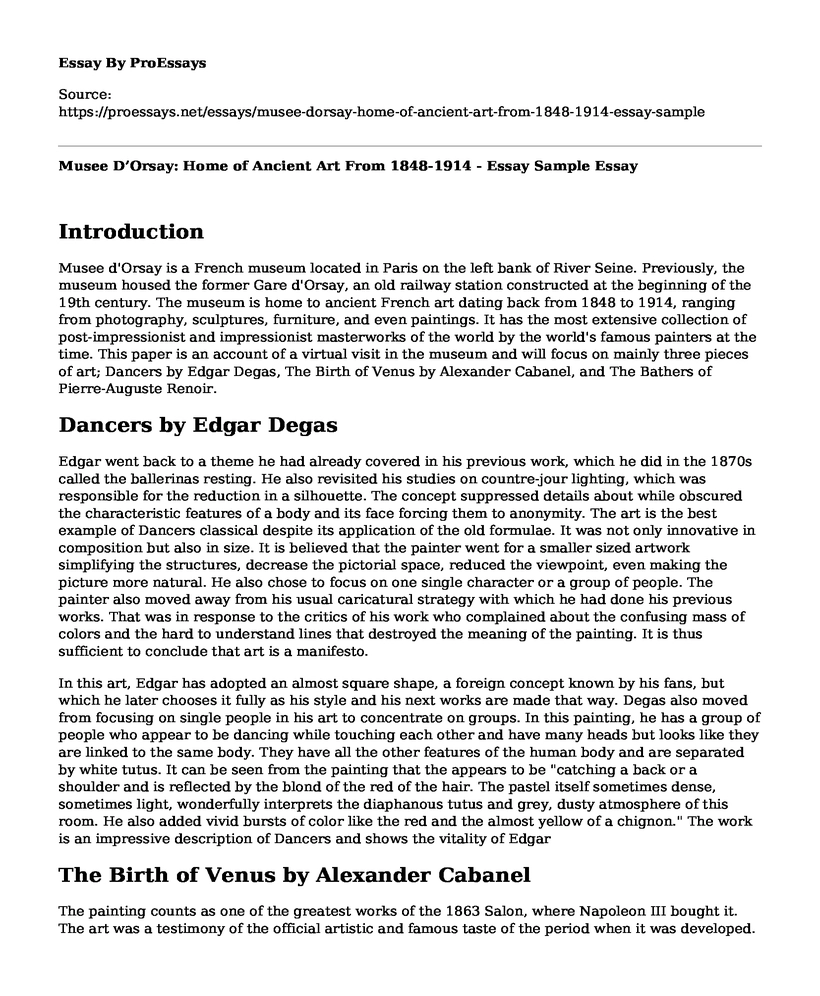Introduction
Musee d'Orsay is a French museum located in Paris on the left bank of River Seine. Previously, the museum housed the former Gare d'Orsay, an old railway station constructed at the beginning of the 19th century. The museum is home to ancient French art dating back from 1848 to 1914, ranging from photography, sculptures, furniture, and even paintings. It has the most extensive collection of post-impressionist and impressionist masterworks of the world by the world's famous painters at the time. This paper is an account of a virtual visit in the museum and will focus on mainly three pieces of art; Dancers by Edgar Degas, The Birth of Venus by Alexander Cabanel, and The Bathers of Pierre-Auguste Renoir.
Dancers by Edgar Degas
Edgar went back to a theme he had already covered in his previous work, which he did in the 1870s called the ballerinas resting. He also revisited his studies on countre-jour lighting, which was responsible for the reduction in a silhouette. The concept suppressed details about while obscured the characteristic features of a body and its face forcing them to anonymity. The art is the best example of Dancers classical despite its application of the old formulae. It was not only innovative in composition but also in size. It is believed that the painter went for a smaller sized artwork simplifying the structures, decrease the pictorial space, reduced the viewpoint, even making the picture more natural. He also chose to focus on one single character or a group of people. The painter also moved away from his usual caricatural strategy with which he had done his previous works. That was in response to the critics of his work who complained about the confusing mass of colors and the hard to understand lines that destroyed the meaning of the painting. It is thus sufficient to conclude that art is a manifesto.
In this art, Edgar has adopted an almost square shape, a foreign concept known by his fans, but which he later chooses it fully as his style and his next works are made that way. Degas also moved from focusing on single people in his art to concentrate on groups. In this painting, he has a group of people who appear to be dancing while touching each other and have many heads but looks like they are linked to the same body. They have all the other features of the human body and are separated by white tutus. It can be seen from the painting that the appears to be "catching a back or a shoulder and is reflected by the blond of the red of the hair. The pastel itself sometimes dense, sometimes light, wonderfully interprets the diaphanous tutus and grey, dusty atmosphere of this room. He also added vivid bursts of color like the red and the almost yellow of a chignon." The work is an impressive description of Dancers and shows the vitality of Edgar
The Birth of Venus by Alexander Cabanel
The painting counts as one of the greatest works of the 1863 Salon, where Napoleon III bought it. The art was a testimony of the official artistic and famous taste of the period when it was developed. Cabanel uses both references to Ingres and style of art used in the 18th Century in a Second Empire's eclectic feature. The painting portrays a nude who is idealized in a sensual way. The ambiguity was denounced by Emile saying, "The goddess drowned in a river of milk, resembles the courtesan, not made of flesh and bone-that would be indecent- but of a pink and white Marzipan." The painting caused a major scandal.The Bathers of Pierre-Auguste-Renoir
It describes the experimentation that Renoir did at the end of his life. He went back to his specialty and expertise, which was nudes on the open air in the year 1910, and produced various huge paintings. He was reminiscing nature's timeless view where there was no reference to the contemporary world as they were all banned. The art can also be used as Renoir's testament in pictorial form as he died in December of 1919. His sons gave the art to the State in 1923 to honor their dad and his proof. The painter painted what he saw in his property in the South of France. He saw two models lying, and three bathers sporting in the stream in the background, and the garden was full of olive trees. The landscape represented that of the Mediterranean found in Greece and Italy at a time when the earth was referred to as the paradise of the gods. He opined that was what he wanted to represent in the paint. The models' sensuality gives more emphasis to idyllic vision together with their full forms and the richness in color. Renoirs got his inspiration from the nudes painted by Reubens and Titian though they did not represent the suffering that he underwent and the illness that affected him.
References
Dancers by Edgar Degas 1884 - 1885https://artsandculture.google.com/asset/dancers/xwE7rgYgnWm68w
The Birth of Venus by Alexandre Cabanel 1863https://artsandculture.google.com/asset/the-birth-of-venus/awEIYqoUcAJ6TA
The Bathers by Pierre-Auguste Renoir 1918 - 1919https://artsandculture.google.com/asset/the-bathers/swG2YS5LNQrRSg
Cite this page
Musee D'Orsay: Home of Ancient Art From 1848-1914 - Essay Sample. (2023, May 23). Retrieved from https://proessays.net/essays/musee-dorsay-home-of-ancient-art-from-1848-1914-essay-sample
If you are the original author of this essay and no longer wish to have it published on the ProEssays website, please click below to request its removal:
- Modernism and Architecture of Antiquity
- The Garden of Forking Paths through Magical Realism - Essay Sample
- Research Paper on Influence of Television on Politics, Family, and Education
- Truth About Alcohol Essay
- Symbolism in Sonnet 67, 75 and 79 by Edmund Spencer
- Artists Massages in Visual Art Paper Example
- Movie Analysis Essay on Giants and Toys: The Rise of Corporate Idol Culture in 1950s Japan







